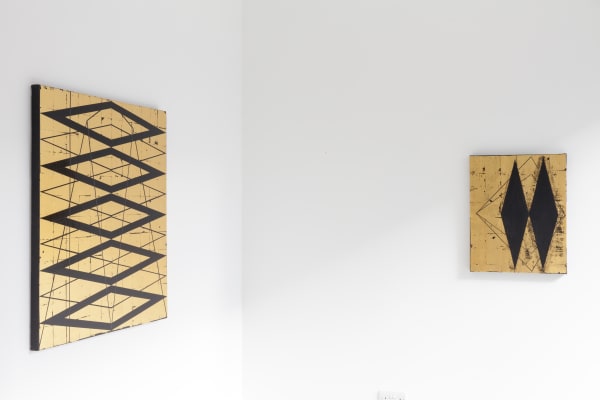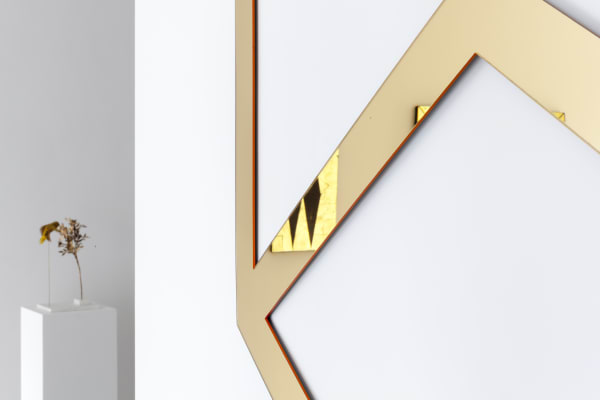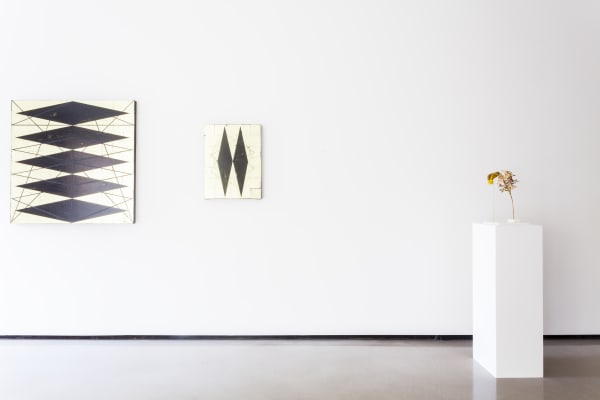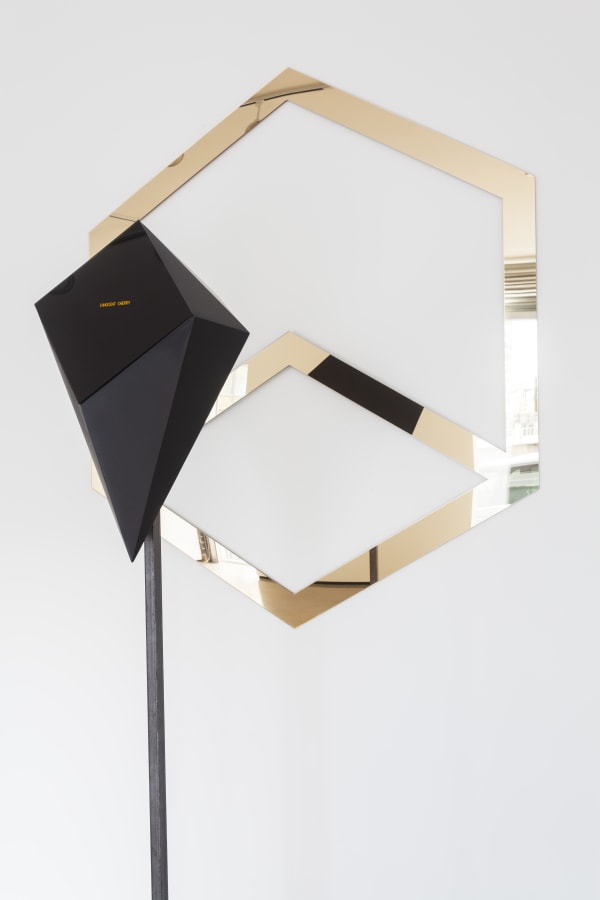AU
Reminiscent of social exclusivity, its association with gods, ancient rulers and nobility, the use of gold in art seems unsuited to the democratic, modern world, where it’s currency has been reduced to exactly that – its monetary weight – and if at all used allegorically, it appears to stand as some pejorative, often overwrought symbol for the pursuit of wealth and commerce. Crucially, an exhibition of ‘gold artwork’ must transcend gold as a color, medium, or theme: a sculpture does not necessarily comment critically on ‘gold’ by merely existing as gold-plated object; simply using gold ‘in colour’ or ‘corporeality’ or as an idea verbatim does not quite seem to grasp what gold can inhabit for the contemporary artist or viewer. Today’s contemporary audiences are too savvy, too well versed in iconography of all sorts (as well as the status of gold*) to consider banal incorporations of ‘gold’ as successful contemporary art.
The artists powerfully gesture toward gold’s natural worth, reconsidering it via its natural and environmental significance, and therefore the exhibition adopts its name from gold’s chemical symbol: Au, pointing to industrialism and the ramifications of globalisation: namely bestowing upon it a kind of toxicity, inherent with a kind of negative personification. If not wary, these artists’ usage of gold appears to be critical, distanced and never directly complicit. Au presents artists who present works in gold rather divorced from their previous religious, historical, cultural and commercial weight, in favor of a consideration of ‘gold’ as a critical concept: we find artists using gold not ironically or satirically, but with cognizance and thought in our society. Here, gold is synonymous with the oil spill, the industrialist waste, the environmental disaster, or the market-crash.
Gold’s allegorical means of exalting religious faith and glory – is once again appropriated for contemplative pastiche (but never satire) – where Andrew Lacon’s tiny golden relics (which were once the fingers and bones of Saints mummified in gold) are modernized as ghostly reminders of industrial yards, former wreckages, and economic superpowers of a ‘once glorious’ economy. Furthermore, the expected portrait of a hallowed Madonna is replaced by Van Leeuwen’s mechanical (and medical) instrumentation, however exactingly poised these instruments may be, Van Leeuwen appears to remind the viewer of their lack of spirit despite their gold constituency.
Orlando Campbell’s ‘oil-spill’ paintings, contrasted with Herrera’s impossibly impudent paper-hummingbirds both emerge as environmental commentary – apropos symbols decked in gold for the ever-imminent apocalypse that inevitably (and seemingly perennially) links both commerce, religion, and environment, from Nostradamus to Y2K to Occupy Wall Street. Further, Rowe’s usage of gold appears as an environmental disaster, a leakage, like the former like an oil tanker awash on the beach, like a momento mori of its once exalted significance. The religious and natural seem entirely replaced the pagan (the suggestion of lunacy intended) toward any one natural resource. Finally, Fabio Lattanzi-Antinori’s shamanistic and technological being: lulling and luring as gold once did – reminding us of the promise of wealth, fortune, fantasy, or religious rapture.
*While the value of gold remains vague and indescribable to the common person, one remains aware that gold bullion is the only stock that has never crashed in its history, thus rendering it’s ‘value’ for commercial trade a symbolic referent of it’s importance both metaphorically and literally in contemporary society.
ORLANDO CAMPBELL
ORLANDO CAMPBELL ( b.1985, United Kingdom) lives and works in London. His artistic practice includes painting, sculpture, gilding, and historic woodcarving. His work sets out to explore the boundaries of painting and sculpture, often combining them to create a new visual language. Campbell did his BA in painting at Central St Martins and a 3 year Diploma in Historic Woodcarving at City & Guilds of London Art school, where he was awarded a Grinling Gibbons Scholarship by the Drapers Company. He has exhibited in Finland and England, and had a solo show The Space Between at 33 Tite Street, London with New Artists in 2012. His work has been exhibited at The Korean Cultural Centre, London, V&A, London, The Cable Factory, Helsinki and Abbott Meade Vickers, London, and he has also worked on an array of diverse projects, including doing the initial designs for the stained glass window in Westminster Hall presented to the Queen for her Diamond Jubilee in 2012. He is currently an artist in residence at The Centre for Recent Drawing, London.
PABLO GRISS
PABLO GRISS (b. 1971 Caracas, Venezuela) graduated from Columbia University School of Visual Arts (1996 ) in New York, where he lived and worked until 1998. He currently works from his studios in Caracas and in Panama City where he has resided since 2008. Pablo has participated in several group and solo exhibitions in the U.S.A, Europe and Latin America. His work, strongly expressionist, had figurative origins that evolved into a distinctive abstract style. In 2010 Griss launched his series Flatline which signaled an adapted style to address the geometric exploration of space. Currently, these elements (such as rhombi and lines) are specific and recognizable. Griss relies on repetition, contrasts and symmetry in compositions where negative spaces are most important as they are seen through the objects he chooses as rendering a simple, abstract and believable space. Exploring materials ranging from raw linen, collage, paint and copper leaf Griss became fascinated with gold leaf in which he found an ever-changing background providing depth and atmosphere to simple, abstract, geometric investigation where order is only apparent. Griss is currently finalizing work on his solo shows scheduled in Panama City and Caracas for 2013. For the second half of 2013 he intends to set up his studio in Berlin so as to take part in new projects.
DIANA BELTRAN HERRERA
DIANA BELTRAN HERRERA (b. 1987, Colombia) studied Design at the Jorge Tadeo Lozano University in Bogota, Colombia where she graduated in 2010. She then studied experimental painting at Guerrero Arts Academy (Bogota) before moving to Helsinki, Finland in 2011 to study Ceramic Sculpture at Suomenkielinen School. Herrera’s work seeks to explore the chillingly disengaged relationship between humans and nature in modern society. Using paper as her primary medium she is able to present notions of temporality and change, emphasizing the process of transformation that continuously occur in nature as well as mankind. Herrera has participated in a number of group and solo exhibitions in her home country since 2011 and also recently had 2 solo exhibitions at Espacio ARTNEXUS (estudio del impacto de un movimiento en el espacio) in Bogota and Garaje Gallery (posturas) in Bogota. During her stay in Helsinki, she was also invited by Hanni Bjartalid (Faroes-Danish artist) to exhibit in Is Anybody Home, a curated display at Nordastlantes brygee Copenaghen, Denmark (Oct-Jan 2011). Diana is currently working on her first commission project for the agency 215 McCann in San Francisco, USA, and in the spring will also be included in the group exhibition The Art and Soul of Paper alongside other international paper-based artists in Norwich, UK.
ANDREW LACON
ANDREW LACON (b.1985 Dudley, England) received his MA from the Royal College of Art, London in 2011 studying Fine Art Photography. Recent exhibitions include the solo show A Magnitude In Albion, OUTPOST, Norwich (2011), and group shows Curiosity Killed the Cat (collaboration with Marie Toseland), Eastside Projects, Birmingham (2013) Approaching Is Distancing, BKS Garage, Copenhagen, Denmark (2012) Prix Leica Europe, Marta Museum & Gallery, Herford, Germany (2011) and SHOW Battersea, Royal College of Art, London (2011). He received the Metro Award (2011) and the National Magazine Award for Fine Art RCA (2010) along with being shortlisted for the Deutsche Bank Art Award (2011). Publications include HARDCOVER: Image Perspectives, (BlackDog Publishing, 2011). He is currently Artist in Residence at UCA (Rochester) and working on the Reference Works commission with the Birmingham Library Photography Archives. Forthcoming projects include Reference Works – book launch, Les Rencontres d’Arles, France (2013), Reference Works – Exhibition, Library of Birmingham (2013)
FABIO LATTANZI ANTINORI
FABIO LATTANZI ANTINORI (b. 1971, Italy) Fabio Lattanzi Antinori’s work is concerned with the individual and the group from a social, historical and cultural perspective and it focuses on the existing relationships between corporate systems, notions of power and control and the language of the interior in the postmodern society. His practice traverses the territory of popular culture in the age of mass information with a specific interest in the sacred role of data, seen as a critical tool to provide an interpretation of reality and an attempt to objectify it. His work has been exhibited internationally in galleries and museums including the V&A in London, the Benaki Museum in Athens, the Royal Institute of British Architects, the Biennal de Valencia, the Gallery of Modern Art in Rome and BEERS in London. From initial studies in philosophy, architecture, music and typography, he has developed a visual language ranging from kinetic sculptures to screen print, photography, performance, video and installations. He is currently finishing his second year at the MFA Computational Studio Arts at Goldsmiths in London, where he currently lives and works.
MATT ROWE
MATT ROWE (b. 1981, United Kingdom) received his MA in Ceramics from the University of Wales Institute Cardiff in 2004. He previously spent 3 years as a student at Buckinghamshire Chilterns University College where he received his BA hon’s in Ceramics and Glass. Rowe has recently attended the funded residencies, 59.14 N 3.34 W curated by Laura Mansfield at the The Erlend Williamson Art Fellowship with support from The Orkney Cultural Fund and Landscape City and People a collaborative residency with artist Mathilde Lavenne at La Malterie, Lille.In 2011 Rowe was selected as artist in residence for the Folkestone Triennial. He is currently part of a group exhibition Make! Believe! Make! at the Portsmouth City Museum in conjunction with Aspex Gallery. Rowe also runs the B&B project space in Folkestone, Kent and is a founding member of Club Shepway arts collective, who have recently released their second publication ‘Vernacular Folk’.
JANNEKE VAN LEEUWEN
JANNEKE VAN LEEUWEN (b.1980, The Netherlands), obtained a Master degree in Neuropsychology before she went to the Gerrit Rietveld Academie in Amsterdam where she specialized in Fine Art Photography. Directly after graduating from the Rietveld Academie in 2009 her work was selected by the prestigious Musée de l’Elysée in Lausanne, Switzerland for the traveling world exhibition ‘reGeneration2: Tomorrow’s Photographers Today’. Van Leeuwens photography has since then been exhibited internationally, amongst others at the Azzedine Alaïa Gallery in Paris, the JustMadrid Artfair 2012, in Madrid, Spain, The Aperture Foundation in New York, the Art Basel Miami Beach, United States and the Pingyao International Photography Festival in China. In March 2011 she had her first solo exhibition at the AJG Gallery in Seville, Spain. In September 2012 she was a selected artist to exhibit in Amsterdam during the first European Conference on ‘Visual Thinking Strategies’, which was developed by Philip Yenawee, the former director of education of the MOMA New York, United States. Since 2011 Janneke van Leeuwen lives and works in London where she is a resident at V22 Artist Studios in Bermondsey. Van Leeuwen’s exhibition proposal Golden Cages for the launch of Art:I:Curate has been recently been selected for exhibition at Gallery 8 on Duke Street, London from the 24th till the 27th of January 2013.











